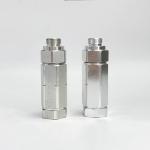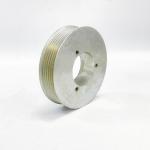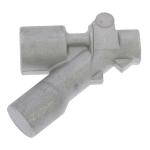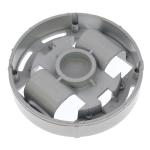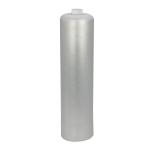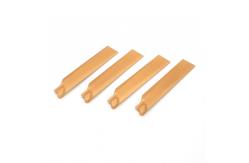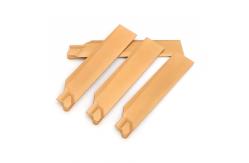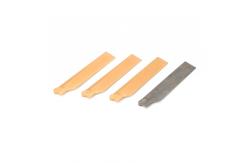Custom/Quenched Aluminum Forging Parts For High Strength For Engine
Parts Product introduction :
Custom and quenched aluminum forging parts are widely used in
high-performance engine components due to their excellent
strength-to-weight ratio, durability, and resistance to wear and
corrosion. Below are key considerations and steps for producing
high-strength aluminum forging parts for engine applications
:
1 . Material Selection
2 . Forging Process Closed-Die Forging : Preferred for engine parts due to its ability to produce
near-net-shape components with high dimensional accuracy and
superior grain structure. Precision Forging : Ensures minimal machining is required post-forging, reducing
material waste and cost. Grain Flow Optimization : Forging aligns the grain structure to enhance strength and
fatigue resistance, critical for engine components.
3 . Heat Treatment (Quenching and Aging) Solution Heat Treatment : Heat the forged part to a specific temperature (e.g., 900°F for
7075) to dissolve alloying elements into the aluminum matrix. Quenching : Rapidly cool the part in water or oil to lock in the solutionized
structure. Aging : Heat the part to a lower temperature (e.g., 250°F for 7075) to
precipitate strengthening phases, enhancing hardness and strength.
4 . Machining and Finishing
5 . Quality Control Non-Destructive Testing (NDT) : Use ultrasonic testing, X-ray, or dye penetrant inspection to
detect internal defects. Mechanical Testing : Verify tensile strength, hardness, and fatigue resistance. Dimensional Inspection : Ensure compliance with design specifications using CMM
(Coordinate Measuring Machine) or laser scanning.
6 . Applications in Engine Parts Pistons : High-strength aluminum forgings reduce weight and improve thermal
efficiency. Connecting Rods : Forged aluminum rods offer excellent strength and fatigue
resistance. Crankshafts : Lightweight and durable forged aluminum crankshafts enhance
engine performance. Valve Train Components : Forged aluminum parts ensure reliability under high stress and
temperature.
7 . Advantages of Custom Quenched Aluminum Forgings High Strength-to-Weight Ratio : Ideal for reducing engine weight while maintaining performance. Durability : Resists wear, fatigue, and thermal stresses. Customization : Tailored to meet specific engine design requirements. Cost-Effectiveness : Reduced material waste and machining time compared to traditional
manufacturing methods.
8 . Partnering with a Forging ManufacturerWhen sourcing custom aluminum forging parts : Choose a manufacturer with experience in aerospace or automotive
applications . Ensure they have capabilities for precision forging , heat
treatment , and quality assurance . Collaborate on design optimization to reduce costs and improve
performance .
By following these steps , you can produce high-strength , custom
aluminum forging parts that meet the demanding requirements of
modern engine systems .
Technical parameter: | Item | Description | | Service | OEM / ODM or Sample Production | | Process Technology | Precision CNC Machining + Surface Treatment | | Material we can cast | grey iron, ductile iron , pig iron,carbon steel, stainless steel,
alloy steel,aluminum alloy, aluminium, A380, aluminum 6061,zincalloy ,copper, brass, bronze CuZn38,H62,etc. | | Size | Customized as customer's drawings | | Weight Range | 0.02-120 KGS | | Application & Service | Metal Parts Solution for Vehicle, Agriculture machine, Construction
Machine, transportation equipment, Valve and Pump system, suchas engine bracket, truck chassis bracket, gear housing , gear
cover, pulley, flange, connection pipe, pipe, hydraulic valve ,valve housing ,Fitting , flange, wheel, fly wheel, oil pump
housing, starter housing, coolant pump housing, transmission shaft
,transmission gear, sprocket, chains etc. | | Heat treatment | Annealing,Solution,Normalizing,Tempering,Quenching,Induction
hardening,Hardening and tempering | | Tolerance | ±0.02mm | | Surface Treatment | Polishing, Plating, Machining, Anodizing, shot, sand blasting, zinc
plated, oxide, galvanized etc. | | Testing | Three coordinate measurement machine for testing.Testing Machine
Digital Height Gauge, caliper,, projection machine, roughness
tester, hardness tester and so on |
| | Certification | ISO9000,TS16949, ISO14001 | | Standard | ISO , DIN, AISI, ASTM, BS, JIS, etc. |
FAQ For Our Company Service:
1 . What are custom/quenched aluminum forging parts ?
Custom/quenched aluminum forging parts are components made from
aluminum alloys that are shaped using a forging process and then
heat-treated (quenched and aged) to achieve high strength,
durability, and performance. These parts are tailored to specific
design requirements for engine applications.
2 . Why use aluminum forgings for engine parts?Lightweight : Aluminum reduces the overall weight of the engine, improving fuel
efficiency and performance. High Strength : Forging enhances the mechanical properties, making the parts
suitable for high-stress environments. Durability : Quenching and aging improve hardness, fatigue resistance, and
wear resistance. Thermal Conductivity : Aluminum dissipates heat efficiently, which is critical for
engine components.
3 . Which aluminum alloys are best for engine parts ?Common high-strength aluminum alloys for engine parts include : 7075-T6 : High strength and toughness, ideal for critical components like
connecting rods. 6061-T6 : Good machinability and corrosion resistance, suitable for pistons
and housings. 2024-T4 : Excellent fatigue resistance, often used for valve train
components.
4 . What is the quenching process, and why is it important ?Quenching involves rapidly cooling the forged aluminum part after solution
heat treatment to lock in the alloy’s microstructure . It is critical for achieving high strength and hardness by
preventing the formation of coarse precipitates.
5 . What engine parts are commonly made from aluminum forgings ?Pistons Connecting rods Crankshafts Valve train components (e.g., rocker arms, valves) Engine blocks and housings Turbocharger components
6 . What are the benefits of custom forging over casting or
machining ?Superior Strength : Forging aligns the grain structure, enhancing mechanical
properties. Better Fatigue Resistance : Forged parts withstand cyclic loads better than cast parts. Material Efficiency : Near-net-shape forging reduces waste and machining time. Customization : Parts can be tailored to specific design and performance
requirements.
7 . How does heat treatment improve aluminum forging properties ?Heat treatment (quenching and aging) enhances : Strength : Precipitates form during aging, increasing hardness. Ductility : Balances strength with the ability to withstand deformation. Fatigue Resistance : Improves the part’s ability to endure repeated stress cycles.
8 . What surface treatments are used for aluminum engine parts ?Anodizing : Improves corrosion resistance and surface hardness. Shot Peening : Enhances fatigue strength by inducing compressive stresses. Coatings : Thermal or ceramic coatings for high-temperature protection.
9 . How do you ensure the quality of forged aluminum parts?Non-Destructive Testing (NDT) : Methods like ultrasonic testing, X-ray, or dye penetrant
inspection to detect internal defects. Mechanical Testing : Tensile, hardness, and fatigue tests to verify material
properties. Dimensional Inspection : Use of CMM (Coordinate Measuring Machine) or laser scanning to
ensure precision.
10 . Can aluminum forgings replace steel in engine parts ?Yes, in many cases : Aluminum forgings are lighter and can provide comparable strength
when properly heat-treated. They are ideal for reducing engine weight and improving efficiency,
though steel may still be preferred for extremely high-stress
applications.
11 . What are the challenges of using aluminum forgings in engines
?Temperature Limits : Aluminum has a lower melting point than steel, limiting its use
in extremely high-temperature areas. Cost : High-strength aluminum alloys and forging processes can be more
expensive than casting or machining. Design Complexity : Custom forgings require precise design and tooling.
12 . How do I choose a manufacturer for custom aluminum forgings ?Look for : Experience in aerospace or automotive forging . Capabilities in precision forging, heat treatment , and machining . Quality certifications (e.g., ISO, AS9100) . Ability to provide design support and prototyping .
13 . What is the typical lead time for custom aluminum forgings ?Lead time depends on :
14 . Are aluminum forgings cost-effective for engine parts ?Yes, in the long run : Reduced weight improves fuel efficiency and performance. Enhanced durability lowers maintenance and replacement costs. Near-net-shape forging minimizes material waste and machining
costs.
15 . Can aluminum forgings be recycled ?Yes, aluminum is highly recyclable : Scrap from forging processes can be reused. Recycled aluminum retains its properties, making it environmentally
friendly.
16 . What are the temperature limits for aluminum engine parts ?Most high-strength aluminum alloys can withstand temperatures up to
300°F to 400°F (150°C to 200°C). For higher temperatures, coatings or alternative materials may be
required.
17 . How do I optimize the design of aluminum forging parts ?Work with the forging manufacturer to simplify geometry and reduce
stress concentrations. Use finite element analysis (FEA) to simulate performance under
load. Consider grain flow direction to maximize strength.
18 . What industries use aluminum forging parts besides automotive
?
By addressing these FAQs, you can better understand the benefits,
processes, and considerations involved in using custom/quenched
aluminum forging parts for high-strength engine applications. |
